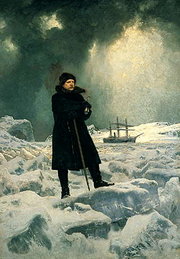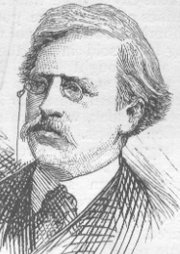|
|

Baron (Nils) Adolf Erik Nordenskiöld, also known as A. E. Nordenskioeld (November 18, 1832 — August 12, 1901) was a Finnish geologist, mineralogist and arctic explorer of Finland-Swedish extraction. Born in Finland he was later forced to live in political exile in Sweden. He is most remembered for the Vega expedition along the northern coast of Europe and Asia. He was also the uncle of Carl Gustaf Emil Mannerheim.
Adolf Erik Nordenskiöld was born in Helsinki, the capital of Finland, but he spent his early youth on the family estate in Mäntsälä. He went to school in Porvoo, a small town on the South coast of Finland. He studied mathematics, chemistry, mineralogy, and geology and gained his masters degree in 1853 at the Imperial Alexander University in Helsinki, and published two years later his dissertation Om grafitens och chondroditens kristallformer (On the crystal forms of the graphite and chondrodite).
In 1856, Nordenskiöld was appointed docent in Mineralogy at the University. However, for political reasons he had to flee in the following year to Sweden, where he was called to the office of Director of the Mineralogical Department of the Swedish Museum of Natural History and to a professorship in Mineralogy at the Swedish Academy of Sciences.
The A.E. Nordenskiöld Collection of maps is located at the University of Helsinki, and it is included in the Memory of the World Register of UNESCO.
| Contents |
Education
Nordenskiöld's father, Nils Gustav Nordenskiöld, was a mineralogist and a traveller. Nordenskiöld entered the Imperial Alexander University in Helsinki in 1849 where he applied himself specially to chemistry and mineralogy. In 1853 he accompanied his father to the Ural Mountains and studied the iron and copper mines at Tagilsk and on his return he received minor appointments both at the university and the mining office.
Having studied for Runeberg he belonged to Liberal, anti-tsarist circles that agitated for Finland's liberation from Russia by the Swedes during the Crimean War; and an unguarded speech at a convivial entertainment in 1855 drew the attention of the Imperial Russian authorities to his political views, and led to a dismissal from the university.
He then visited Berlin, continuing his mineralogical studies, and in 1856 obtained a travelling stipend from the university in Helsinki and planned to expend it in geological research in Siberia and Kamchatka. Upon returning he took his masters and doctor's degree in 1857 as a scholar of chemistry and geology, specialized in iron and copper-mining. He then aroused the suspicion of the authorities again, so that he was forced to leave Finland, practically as a political refugee, and was deprived of the right of ever holding office in the university of Finland.Settling in Stockholm
As Nordenskiöld spoke Swedish as his mother tongue, a natural place for him to settle was nearby Stockholm. He soon received an offer from Otto Torch, the geologist, to accompany him on an expedition to Spitsbergen. To the observations of Torell on glacial phenomena Nordenskiöld added the discovery at Bell Sound of remains of Tertiary plants, and on the return of the expedition he received the appointment of professor and curator of the mineralogical department of the National Museum of Natural History (Naturhistoriska Riksmuseet).
Nordenskiöld's participation in three geological expeditions to Spitsbergen, followed by longer Arctic explorations in 1867, 1870, 1872 and 1875, led him to attempt the discovery of the long-sought Northeast Passage. This he accomplished in the voyage of the Vega, navigating for the first time the northern coasts of Europe and Asia. Starting from Karlskrona on June 22, 1878, the Vega doubled Cape Chelyuskin in the following August, and after being frozen in at the end of September near Bering Strait, completed the voyage successfully in the following summer. He edited a monumental record of the expedition in five octavo volumes, and himself wrote a more popular summary in two volumes.
On his return to Sweden he received an enthusiastic welcome, and in April 1880 was made a baron and a commander of the Order of the North Star. In 1883, he visited the east coast of Greenland for the second time, and succeeded in taking his ship through the great ice barrier, a feat attempted in vain during more than three centuries.
In 1893, Baron Nordenskiöld was elected to the 12th chair of the Swedish Academy. The Nordenskiöld crater on Mars was named in his honor.
Expeditions
- In 1858, 1861, and 1864 he went with expeditions to Spitsbergen, and in 1868 he went in a small vessel farther north than any vessel had ever been in the Eastern hemisphere. In 1861 he took part in Tbrells second Spitsbergen expedition and in 1864 he himself the leader of the expedition promoted by the Swedish Royal Academy of Science.
- In 1870, he visited Greenland and in 1871 went again to Spitsbergen and stayed there all winter, nearly starving to death.
- In the expeditions of 1872 and 1875, he headed a well-organized expedition in the iron steamer Sofia, and reached the highest northern latitude (+81° 42 min) then attained in the eastern hemisphere.
- In 1875, he went to the Yenisei River in Siberia, in a small vessel, which he sent back while he went up the river and returned home by land. The next year he went to the United States and was a juror at the Centennial Exhibition.
- In 1878 he sailed around the north coast of Asia, returning home by the way of the Bering Strait, being the first to make the whole length of the Northeast passage. This he accomplished in the voyage of the Vega, navigating for the first time the northern coasts of Europe and Asia. Starting from Karlskrona on June 22, 1878, the Vega doubled Cape Chelyuskin in the following August, and after being frozen in at the end of September near Bering Strait, completed the voyage successfully in the following summer.
External links
- Characters from real life who appeared in Carl Barks's and Don Rosa's stories (http://goofy313g.free.fr/calisota_online/exist/nordenskiold.html)
- A. E. Nordenskiöld and his Collections in Helsinki University Library (http://www.lib.helsinki.fi/english/services/collections/nordenskeng.html)de:Adolf Erik Nordenskiöld
fi:Adolf Erik Nordenskiöld fr:Adolf Erik Nordenskiöld sv:Adolf Erik Nordenskiöld

